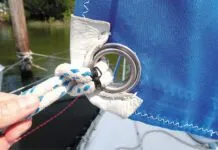Silicone for Lexan
I am planning to replace the windows in my Sabre 28 and found your recent article on sealants helpful. I plan to use a clear silicone to seal the frame to the Lexan window on the outside. There is one bit of clarification I need. Your article says the silicones that have the familiar smell of vinegar are acid-based. I called GE to find out if they make an ammonia-based silicone. They said their Silicone II is ammonia-based (which smells) and the smell is of ammonia. Im a bit confused.
Secondly, I have been advised to use only 100% silicone for this application. Your article failed to mention any 100%-silicone products that are ammonia-based. Can you help me locate such a product, if one exists?
Allen Hare
via e-mail
It is possible for some ammonia-based silicones to have an odor, depending on the manufacturer. This odor, however, will be unlike the traditional vinegar smell generated by acid-based products. In the article we were referring to marine-grade silicones which have been de-skunked and are essentially odorless. The product we like is BoatLife Marine Silicone Sealant, which is ammonia-based and 100% silicone. Its available from the major mail-order houses and in most chandleries. Tubes cost about $4 and cartridges about $7. The part number for a clear cartridge is 1150.
Remember, 100% silicone will not take paint. If you want to paint it, consider Sikaflex 245UV designed especially for Lexan/Plexiglas. Its more expensive and polyurethane-based. This particular Sika product isn’t in many of the catalogs. It can be ordered from Sika, 22211 Telegraph Rd., Southfield, MI 48034; 810/353-2150.
What Metal for Seizing?
This is about Nick Nicholsons one-page article in the August 1, 1998 issue about the electroplating disappearing on the pin in his high-tensile anchor shackle. He recommends that an anchor shackle pin should be seized with stainless or Monel wire. Thats presumably what he had done. I think the culprit is the wire seizing. A recent English magazine had a story about the issue of galvanic corrosion. The seizing should be galvanized wire to avoid electrolysis.
Gary L. Irving
Dedham, Massachusetts
Because galvanized steel is far removed in the galvanic series from 316 stainless or Monel, youre technically correct. The problem with galvanized wire is that some of the thin galvanizing always gets scraped off when the wire is twisted or worn off by abrasion. Then the thin wire rusts very quickly and breaks or disappears. Not good.
Thats why stainless or Monel is preferred, especially for shackles that spend most of their time out of the water.
But what about that insidious galvanic corrosion?
The amount of galvanic action that occurs between two dissimilar metals is dependent on three factors: (1) how far apart they are on the scale, (2) an electrolyte connecting them electrically, and (3) the relative amount of the two metals that when immersed become a cathode and an anode. (Theres another factor involving the insulating salts and oxides that may be produced and whether there is enough water movement to wash them away.)
Its #3 above that makes it reasonable to seize a galvanized shackle with a stainless or Monel wire. The pure bulk of the galvanized shackle (the anode) is so great compared with a tiny amount of wire (the cathode) that the current flow and resultant material loss on the cathode is minuscule and therefore not a big worry.
However, as Nick Nicholson said, if your anchor spends a lot of time in the water (especially saltwater), it pays to check everything frequently.
Switch Failure
Is there a special way to keep bilge sump switches? The reason I am asking is that the Rule-A-Matics on my Hunter 34 seem to have a life span of about two seasons. Each fall at haul-out I drain the bilge sump so it is not subject to frost/freeze damage. But the switch float loses the desired tendency to rise on its own. The ability to make the electrical connection once the switch is elevated is intact. I reread your published review of bilge sump switches and did not find any specific care instructions, so I am assuming that these failures are just normal, but the frequency seems high.
Ronald Ingham
Warren, Michigan
If your Rule-A-Matic still makes electrical contact, then it has lasted longer than many. Over the years, we have received many failed Rule switches sent in by readers. The usual cause is water migration along the electrical wires, leading to corrosion. If the switch is not lifting easily, then perhaps there is either dirt or corrosion along the pivot, which can be cleaned.
In earlier articles, we have found the Ultra Jr. and Sr. to be the most failure-proof switch available. They are expensive, but all electrical components are above the water. West Marine sells them for $90 and $125. If you depend on a bilge pump switch, theyre worth the extra cost.



































